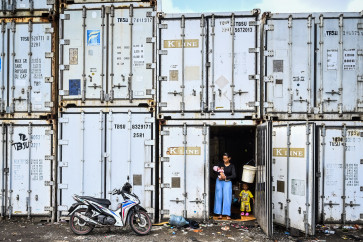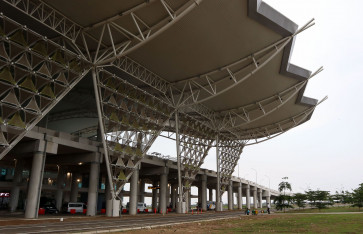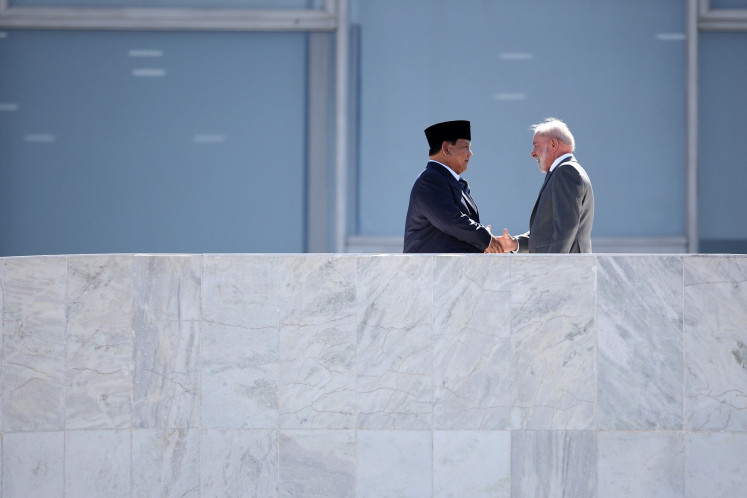Popular Reads
Top Results
Can't find what you're looking for?
View all search resultsPopular Reads
Top Results
Can't find what you're looking for?
View all search resultsXL to expand network to cover 95% of population in 2019
Publicly listed telecommunications operator PT XL Axiata is planning to reach 95 percent of Indonesia’s 260 million people by building and operating more base transceiver stations (BTS) across the country
Change text size
Gift Premium Articles
to Anyone
P
ublicly listed telecommunications operator PT XL Axiata is planning to reach 95 percent of Indonesia’s 260 million people by building and operating more base transceiver stations (BTS) across the country.
The company’s technology director, Yessie D. Yoseta, said XL Axiata had completed 90 percent of its planned network infrastructure development for 2019 in the first six months of the year by installing 19,000 new BTS, mostly in areas outside Java.
"We are supporting the government’s universal service obligation [USO] program by installing 250 4G BTS in 51 cities in East Nusa Tenggara, Maluku and Papua this year,” she said at a press conference on Thursday.
As of June, the operator, which is one of Indonesia's top three telecommunications firms, owned 127,257 BTS, of which 37,323 are for 4G, 53,260 for 3G and 36,674 for 2G.
XL, whose stocks ticker at the Indonesia Stock Exchange (IDX) is EXCL, plans to install 135,000 BTS in more than 440 cities by the end of this year in a bid to reach 95 percent of the country’s population.
To achieve this goal, it has allocated up to 80 percent of its Rp 7.5 trillion (US$530 billion) in capital expenditure (capex) to strengthening the company's infrastructure.
The company's network expansion will also use the backbone fiber optics cables of the Palapa Ring nationwide broadband network that have been installed in the western and middle parts of Indonesia, Yessie said.
She also revealed that the company had connected 30 percent of its coverage area to the fiber optic network with a plan to increase this figure to 50 percent by year-end and 70 percent by the end of next year.
The connecting process is expected to improve the network capacity five-fold and enable superfast 5G technology.
“Our customers will enjoy a better and more seamless data experience,” Yessie said.
Despite having already made the first step toward introducing 5G network in Indonesia, XL Axiata president director and CEO Dian Siswarini said the company would start preparing for the technology in the next two to three years.
Currently, XL’s 4G network is available in around 408 cities and areas covered by more than 37,000 BTS with more than 56 million users. In the first half, its subscribers grew 24 percent annually to 48.6 million.
Finance director Adlan bin Ahmad Tajuddin said both of XL Axiata’s brands, XL and Axis, were growing fast because they are able to cater two different market segments. The brand Axis caters to the needs of the mass segment while XL is more popular among blue-collar workers.
“Our business performance must be stronger than the first half,” he said, adding that the company expected to double its first half’s net profit of Rp 282.4 billion by the end of this year.
XL’s revenue stood at Rp 12.26 trillion as of June, up almost 11 percent compared to the same period last year, its financial report filed to the IDX showed.
Adlan said the two main drivers of XL Axiata's business are its 4G data growth and expansions outside Java.
The company’s revenue from data soared to Rp 9.13 trillion in the first half of this year compared to Rp 6.99 trillion booked in the corresponding period of 2018. Meanwhile, its revenue from non-data services declined to Rp 1.98 trillion as of June versus Rp 2.71 trillion during last year’s first half.
XL Axiata shares were valued at Rp 3,270 apiece on Friday. The shares gained 10.85 percent year-on-year (yoy), outperforming the broader Jakarta Composite Index’s (JCI) 10.52 percent return, Bloomberg data showed. (eyc)










